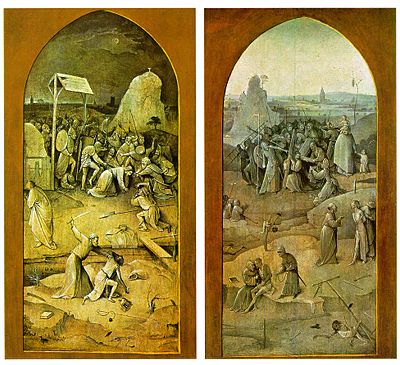
Hieronymus Bosch was a Dutch/Netherlandish painter from Brabant. He is one of the most notable representatives of the Early Netherlandish painting school. His work, generally oil on oak wood, mainly contains fantastic illustrations of religious concepts and narratives. Within his lifetime his work was collected in the Netherlands, Austria, and Spain, and widely copied, especially his macabre and nightmarish depictions of hell.

The Garden of Earthly Delights is the modern title given to a triptych oil painting on oak panel painted by the Early Netherlandish master Hieronymus Bosch, between 1490 and 1510, when Bosch was between 40 and 60 years old. It has been housed in the Museo del Prado in Madrid, Spain since 1939.

The Temptation of Saint Anthony is an often-repeated subject in the history of art and literature, concerning the supernatural temptation reportedly faced by Saint Anthony the Great during his sojourn in the Egyptian desert. Anthony's temptation is first discussed by Athanasius of Alexandria, Anthony's contemporary, and from then became a popular theme in Western culture.

The Haywain Triptych is a panel painting by Hieronymus Bosch, now in the Museo del Prado, Madrid, Spain. A date of around 1516 has been established by means of dendrochronological research. The central panel, signed "Jheronimus Bosch", measures 135 cm × 200 cm and the wings measure 147 cm × 66 cm. The outside shutters feature a version of Bosch's The Wayfarer.

The Seven Deadly Sins and the Four Last Things is a painting attributed to Hieronymus Bosch or to a follower of his, completed around 1500 or later. Since 1898 its authenticity has been questioned several times. In 2015 the Bosch Research Conservation Project claimed it to be by a follower, but scholars at the Prado, where the painting hangs, dismissed this argument. The painting is oil on wooden panels and is presented in a series of circular images.

The Conjurer is a painting by Early Netherlandish painter Hieronymus Bosch or his workshop, executed around 1502.
Death and the Miser is a Northern Renaissance painting by Hieronymus Bosch produced between 1490 and 1516 in Northern Europe. The piece was originally part of a triptych, but the center piece is missing. It is a memento mori painting, which is meant to remind the viewer of the inevitability of death and the futility of the pursuit of material wealth, illustrating the sin of greed.
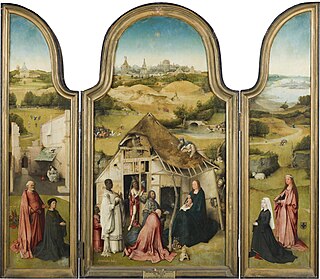
The Adoration of the Magi or The Epiphany is a triptych oil painting on wood panel by the Netherlandish artist Hieronymus Bosch, executed around 1485–1500. It is now in the Museo del Prado in Madrid, Spain.

Christ Carrying the Cross is a painting attributed to a follower of Hieronymus Bosch. It was painted in the early 16th century, presumably between 1510 and 1535. The work is housed in the Museum of Fine Arts in Ghent, Belgium. The painting is notable for its use of caricature to provide grotesque-looking faces surrounding Jesus.
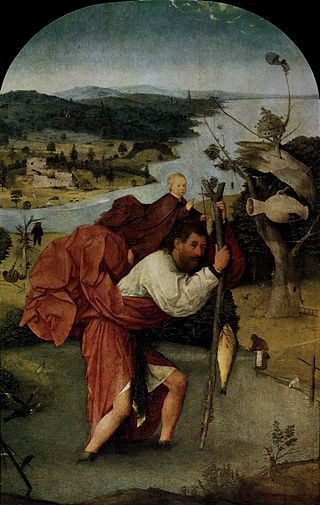
Saint Christopher Carrying the Christ Child is an oil on panel painting by Dutch painter Hieronymus Bosch, dating to c. 1490-1500. It is held at the Museum Boijmans Van Beuningen in Rotterdam.

The Crucifixion of Saint Wilgefortis is a c. 1497 triptych by the Early Netherlandish painter Hieronymus Bosch. The subject of the painting has been uncertain, and it has also been known as the Triptych of the Crucified Martyr, or The Crucifixion of Saint Julia, but is now believed to depict Saint Wilgefortis.

The Hermit Saints is a religious oil on panel painting displayed as a triptych, meaning it is one whole painting composed of three separate scenes. This artwork was made by the Renaissance artist Hieronymus Bosch, dating from 1493. The entirety of the triptych painting measures 86 by 60 centimetres. This artwork is currently being housed at the Gallerie dell'Accademia, Venice.
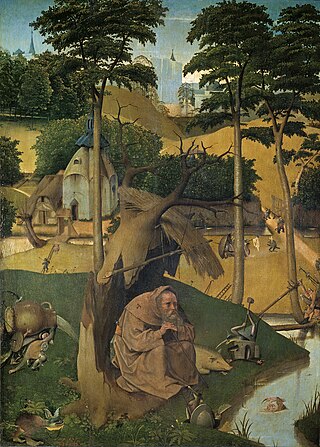
The Temptation of St. Anthony is a painting of disputed authorship, attributed to either Hieronymus Bosch or a follower. It is now in the Museo del Prado, in Madrid.

The Last Judgment is a triptych by Hieronymus Bosch, created after 1482.
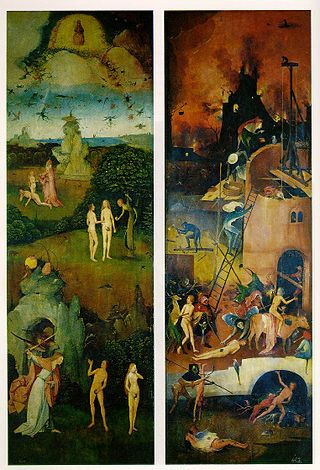
Paradise and Hell is the left and right panels of a minor diptych by a follower of Hieronymus Bosch based on The Haywain Triptych. The image is oil on panel and is 135 x 45 cm. It was painted c. 1510 and is now in the Museo del Prado, Madrid. Paradise is depicted darker than in the Haywain, which possibly represents the darkness of original sin.

The Last Judgment is a triptych of disputed authorship, either by Hieronymus Bosch, his workshop, or a collaboration between artist and workshop. It was created after 1486.
Jheronimus Bosch—Visions of Genius was a 2016 art exhibition at the Noordbrabants Museum in 's-Hertogenbosch, the Netherlands, about the work of Hieronymus Bosch, a native of 's-Hertogenbosch.

The Temptation of Saint Anthony is a single-panel painting by Hieronymus Bosch, executed c. 1500–1510. It is housed in the Nelson-Atkins Museum of Art in Kansas City.

Hieronymus Bosch, Touched by the Devil is a 2015 Dutch documentary film directed by Pieter van Huystee about the Dutch artist Hieronymus Bosch. It documents how The Haywain Triptych is exhibited in Bosch's hometown of 's-Hertogenbosch for the first time in almost 500 years.
Proto-Surrealism is a term used for Surrealism avant-la-lettre. It is the study of various forms of art, literature, and other mediums that correspond to, reference, or share similarities to the 20th-century art movement known as Surrealism. This definition is considered a controversial topic, with many debating the suitability of the term surrealism to describe these bodies of work and instead opting to use the term Fantastique or Fantastic Art.









